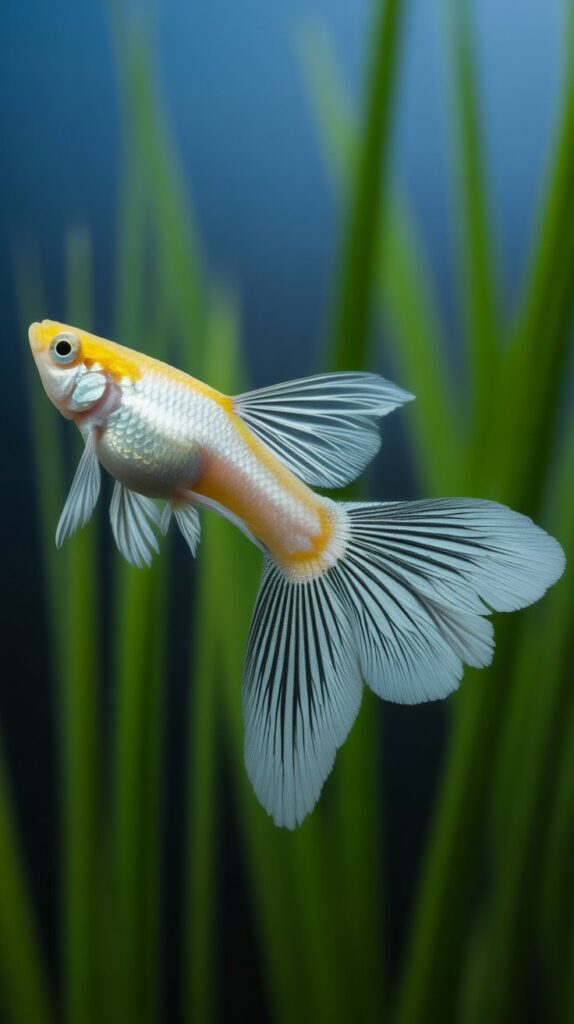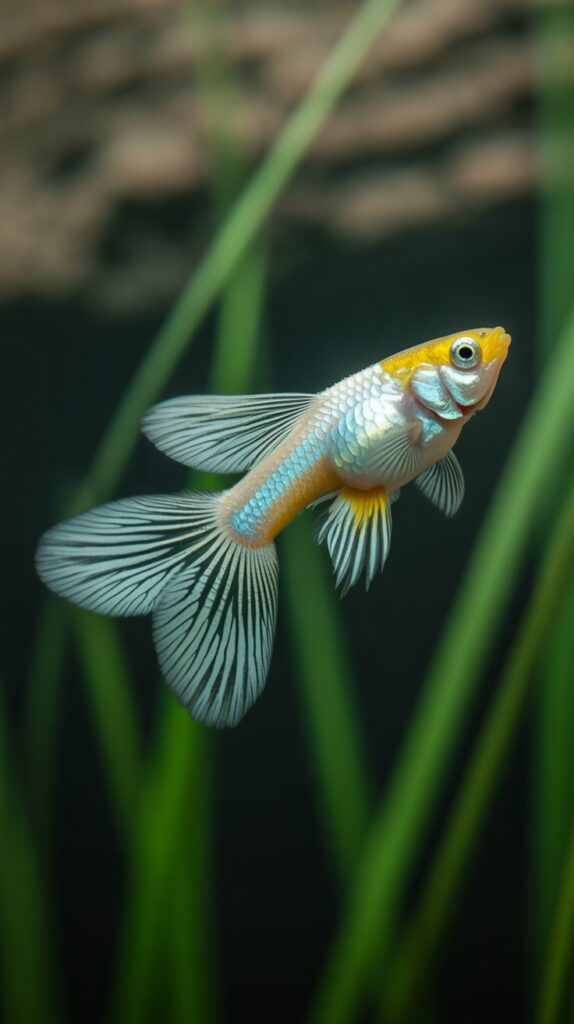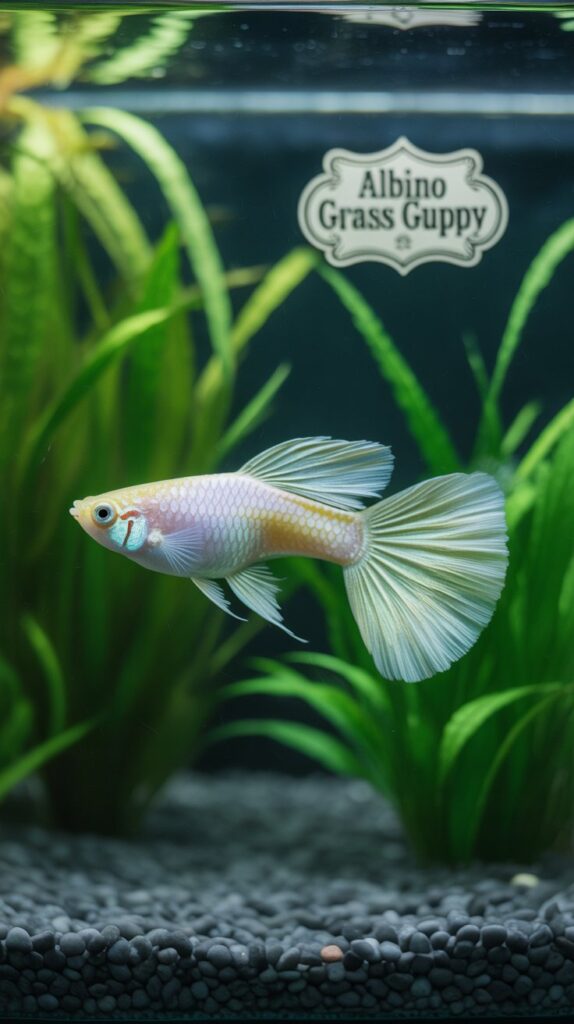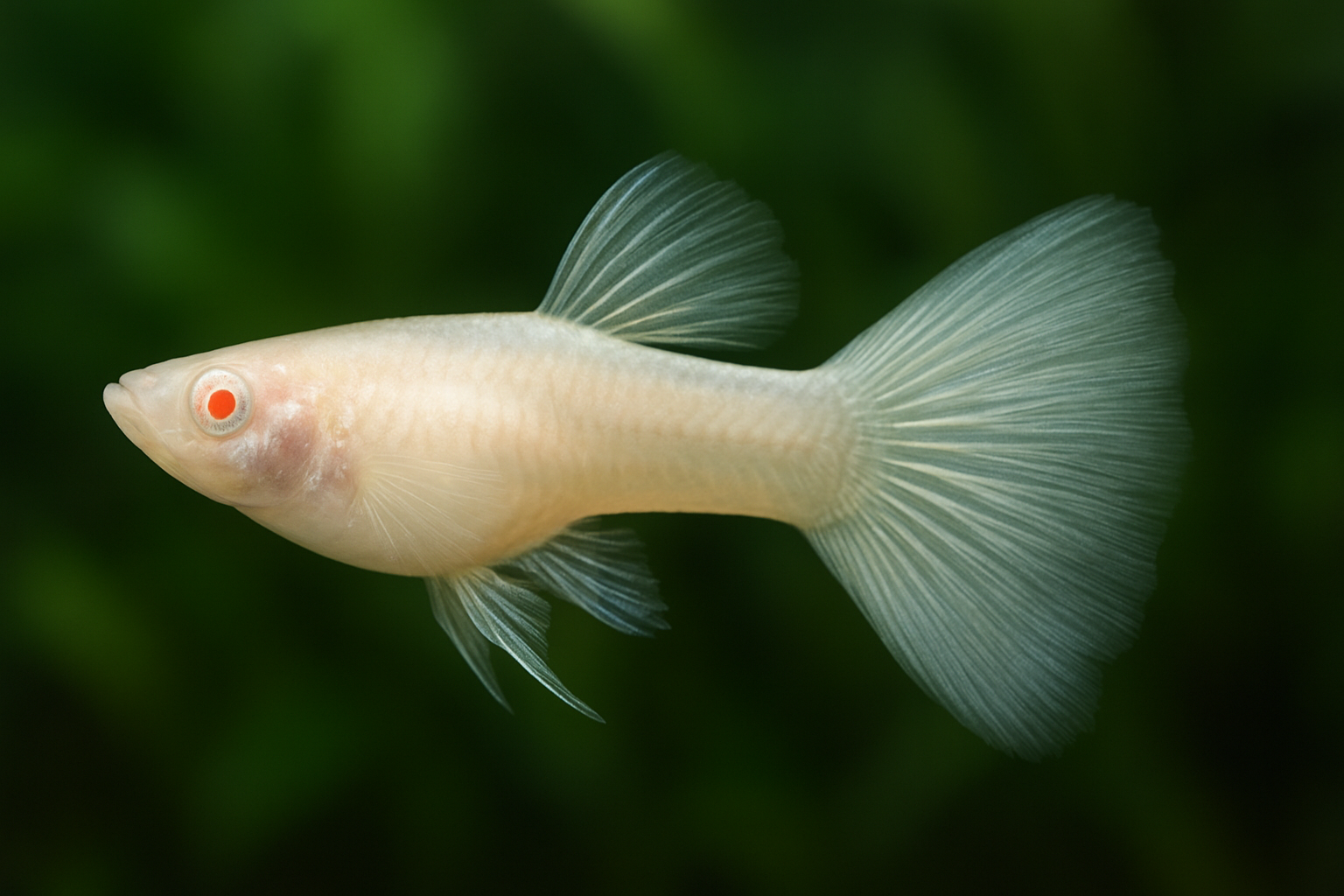The Albino Grass Guppy is one of the most beautiful and sought-after guppy varieties in the aquarium hobby. Known for its elegant grass-like tail pattern and striking albino body, this guppy offers both rarity and visual appeal. Whether you are a beginner or an experienced aquarist, understanding the proper care, breeding techniques, and maintenance of Albino Grass Guppies is essential for keeping them healthy and vibrant.
In this comprehensive guide, we will cover everything you need to know about the Albino Grass Guppy, from its origin and physical characteristics to diet, breeding, and tank setup.
1. Introduction to Albino Grass Guppy
The Albino Grass Guppy is a selectively bred variant of the Poecilia reticulata species. This guppy is characterized by its lack of black pigment (due to the albino gene) and its grass-like tail patterns, which often appear in blue, green, or multicolored shades. The albino genetics give the fish a pale white or pinkish body, with striking red or pink eyes.

Because of its unique coloration, the Albino Grass Guppy stands out in any aquarium setting, making it a popular choice for ornamental fish enthusiasts.
2. Origin and History
Guppies originate from South America, particularly in countries such as Venezuela, Guyana, and northern Brazil. Over the years, guppies have been selectively bred for color, tail shape, and pattern.
The Albino Grass Guppy is a result of combining the albino trait (lack of melanin) with the grass pattern gene. This type of breeding requires careful selection to maintain both the albino coloration and the intricate grass-like tail design.
3. Physical Characteristics
Albino Grass Guppies are admired for their delicate appearance and vibrant tail patterns. Here are some defining features:
- Body Color: Pale white, cream, or light pink.
- Eye Color: Red or pink (due to albinism).
- Tail Pattern: Fine, grass-like streaks radiating outward, often in blue, green, or iridescent shades.
- Size: Males reach about 1.5–1.8 inches; females are larger, around 2–2.5 inches.
- Sexual Dimorphism:
- Males are smaller with more vibrant coloration.
- Females are bigger with less intense tail colors.
4. Behavior and Temperament

Albino Grass Guppies are peaceful, social, and active swimmers. They do well in community tanks with other non-aggressive fish such as mollies, platies, and tetras.
Key behavior traits include:
- Schooling in small groups.
- Constant swimming in the middle and upper tank levels.
- Males displaying courtship dances to attract females.
5. Tank Requirements for Albino Grass Guppy
A proper tank setup is crucial for the health and well-being of your guppies.
Tank Size
- Minimum 10 gallons for a small group.
- Larger tanks (20–30 gallons) are ideal for breeding or community setups.
Water Parameters
- Temperature: 72–82°F (22–28°C)
- pH: 6.8–7.8
- Hardness: 8–12 dGH
- Ammonia/Nitrite: 0 ppm
- Nitrate: Below 20 ppm
Filtration
A sponge filter or hang-on-back filter works well, providing both mechanical and biological filtration.
Substrate and Décor
- Fine gravel or sand substrate.
- Live plants like guppy grass, java moss, and anacharis to mimic their natural habitat.
- Hiding spots made of driftwood or decorations.
6. Diet and Feeding

Albino Grass Guppies are omnivorous and thrive on a varied diet.
Recommended Foods:
- High-quality guppy flakes or micro-pellets.
- Frozen or live brine shrimp.
- Daphnia.
- Microworms.
- Blanched vegetables like spinach or zucchini (as an occasional treat).
Feed them 2–3 times daily in small portions they can consume within 2 minutes.
7. Breeding Albino Grass Guppy
Breeding is relatively easy, but maintaining the albino grass traits requires selective pairing.
Breeding Steps:
- Set up a separate breeding tank (5–10 gallons) with gentle filtration and live plants.
- Keep a ratio of 1 male to 2–3 females to prevent stress.
- Females give birth to live young after a gestation period of 21–30 days.
- Once fry are born, separate them from adults to avoid predation.
Fry Care:
- Feed crushed flakes, baby brine shrimp, or microworms.
- Keep water clean and maintain stable parameters.
8. Common Health Issues
Albino Grass Guppies are hardy, but they can be prone to certain diseases if water quality is poor.
- Ich (White Spot Disease) – Treated with heat and aquarium salt or medication.
- Fin Rot – Caused by bacterial infections; treated with antibacterial meds.
- Velvet Disease – Treated with copper-based medication.
- Swim Bladder Disorder – Often related to poor diet or water quality.
Prevent issues by:
- Keeping water clean.
- Avoiding overfeeding.
- Quarantining new fish before introducing them to the main tank.
9. Tank Mates for Albino Grass Guppy

Good companions include:
- Other guppy varieties.
- Mollies.
- Platies.
- Corydoras catfish.
- Neon tetras.
- Endler’s livebearers.
Avoid aggressive species like cichlids or tiger barbs.
10. Why Choose Albino Grass Guppy?
- Unique Appearance: Rare albino coloring with elegant tail patterns.
- Beginner-Friendly: Easy to care for and breed.
- Peaceful: Great for community aquariums.
- Active Swimmers: Provide constant movement and beauty in tanks.
11. Albino Grass Guppy Care Tips
- Keep a male-to-female ratio of 1:2 or 1:3 to prevent harassment.
- Maintain stable water conditions to preserve health and color vibrancy.
- Provide a plant-rich environment for hiding and breeding.
- Perform 25–30% water changes weekly.
12. Conclusion
The Albino Grass Guppy is a stunning and peaceful addition to any aquarium. Its combination of rare albino genetics and grass tail patterns makes it a favorite for both beginners and seasoned hobbyists. With proper care, nutrition, and a good environment, these guppies can live for 2–3 years and bring endless beauty to your aquarium.
FAQs About Albino Grass Guppy
1. How long do Albino Grass Guppies live?
They typically live for 2–3 years with good care and proper diet.
2. Can Albino Grass Guppies live with other fish?
Yes, they are peaceful and do well with other non-aggressive species.
3. How many Albino Grass Guppies should I keep together?
Keep them in groups of at least 5–6 for social interaction.
4. Do Albino Grass Guppies need a heater?
Yes, they thrive in warm water, so a heater is recommended to maintain 72–82°F.
5. How often should I feed Albino Grass Guppies?
Feed them 2–3 times a day in small portions.
6. Can I breed Albino Grass Guppies easily?
Yes, they breed readily, but maintaining pure albino grass traits requires selective breeding.
7. Do Albino Grass Guppies require special lighting?
Standard aquarium lighting works fine, but LED lights enhance their colors.

